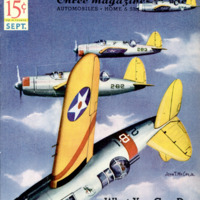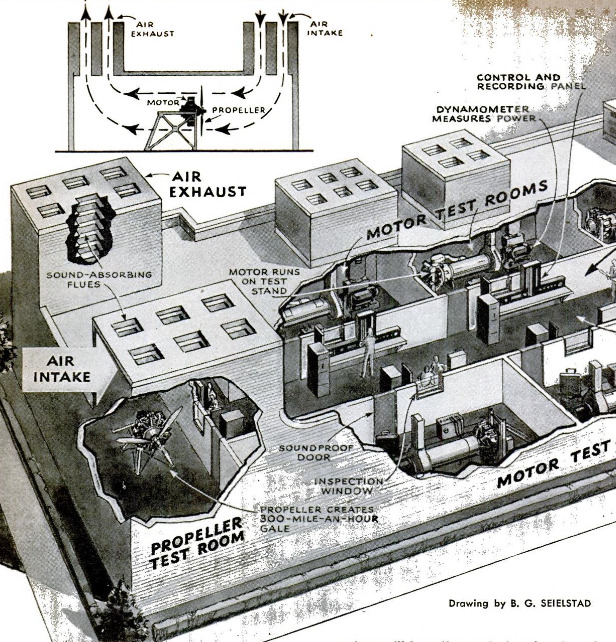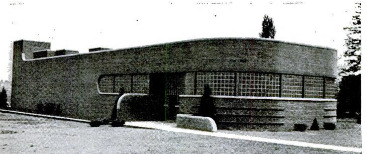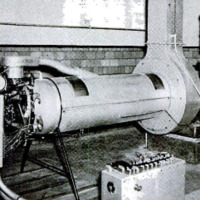-
Title (Dublin Core)
-
Housing a hurricane: soundproof laboratory built to test airplane motors
-
Article Title and/or Image Caption (Dublin Core)
-
Title: Housing a hurricane: soundproof laboratory built to test airplane motors
-
extracted text (Extract Text)
-
NOISES too loud for their full blast to
be heard will fill soundproof rooms,
when aviation engines of up to 2,000
horsepower go into action, in the University
of Kentucky's new motor and propeller test-
ing laboratory at Lexington. Acoustic ex-
perts rate the combined roar of such a pow-
er plant and the shriek of its propeller at
upwards of 150 decibels, or sound units. Hu-
‘man ears respond only to about 120 decibels;
above that crescendo of pandemonium, they
distinguish nothing louder.
Sounds of such intensity, 1,000,000 times
greater than those of a busy street corner,
not only are nerve-racking but actually dan-
gerous to health. A man without ear plugs,
entering a room where an air motor is run-
ning under full throttle and heavy load,
would suffer temporary deafness at least. |
Even with ears protected, many persons
would be affected with nausea.
For this reason, workers go into the five |
motor test rooms, and the propeller-testing
section at the end of the laboratory, only to
make preliminary adjustments. Then, clos-
ing soundproof doors, they withdraw to a |
central observation room from which the
ignition, throttle, and spark advance of each
motor may be operated by remote control.
While engines pit their strength against
measuring devices called dynamometers—in
principle nothing more than giant brakes—
observers look on through thick windows
and read dials and gauges. Manometers
give pressure readings, electric thermom-
eters show the temperature at 28 different |
points on an engine wader test, a tachometer |
Indicates revolutions per min-
ute, and a gasoline meter
checks fuel consumption, giv-
ing a thorough picture of the
motor’s performance under
widely variable operating
conditions. Lest poisonous
exhaust gas seep into the ob-
servation gallery, its ventilat-
ing system maintains a slight
ly higher air pressure than in
the surrounding test rooms.
Through the propeller-test-
ing section, during a trial,
rushes an artificial hurricane
of 300-mile-an-hour speed.
Drawing in and discharging
a volume of 2,500,000 cubic
feet of air a minute, while
straining out noises that
would shatter the academic
calm of the campus and be-
devil residents in the neigh-
borhood, presented a major
problem. Sound engineers
solved it in a remarkable way.
Incoming and outgoing air
streams both pass through
multiple flues in towers atop
the building. Sawtooth bricks
of sound-absorbing material
line the flues. Angles of the
brick ends have been so clev-
erly calculated that a sound
wave echoing from one will
be sure to strike another, and
another, until its force dies
out within the flue. The action might be
compared to that of a billiard ball losing
some of its momentum each time it caroms
off a rail of the table, and finally coming
to rest.
Only sound waves that enter the flues in
an absolutely vertical direction can escape,
and these travel upward to great altitudes
and dissipate themselves in the sky. Once
in a while, it is true, peculiar atmospheric
conditions may give the upper air the sound-
reflecting quality of a whispering gallery.
Then people as far as 12 miles from the lab-
oratory will hear the mysterious buzzing of
“ghost” airplanes apparently coming from
overhead.
Rooms for dratting, assembling, lockers,
tools, and a self-contained power plant
complete the ultramodern laboratory. Huge
underground storage tanks outside the
building feed fuel to the greedy motors—a
1,000-horsepower motor consumes 100 gal-
lons of gasoline in an hour. City water, of
all things, supplies the needed pressure. The
gasoline floats on top of water admitted
through mains to the bottom of the tanks,
since it is lighter, and is thus forced into a
fuel pipeline system running through the
laboratory. An automatic regulating device
controls the flow of water from the mains,
with the result that fuel is fed from the
tanks at uniform pressure.
The establishment, it has been announced,
will take a direct part in national defense
by serving as a power-plant branch for the
U. S. Army Air Corps’ program of training
and research. Hand-picked engineers will
go there to receive a 12-weeks course in lab-
oratory technique and methods.
In addition to the testing and studying
of actual production-model airplane engines,
the laboratory will be used for conducting
researches with experimental one-cylinder
engines to help solve new problems in com-
bustion, lubrication, cooling, and mechanism.
With the great increase in plane production,
the importance of research is obvious.
Directing the work of the laboratory is
A. J. Meyer, who was superintendent of the
Fokker Aircraft Company at Amsterdam,
Holland, 20 years ago and more recently has
served as research engineer for several lead-
ing American aeronautical corporations. He
holds more than 125 patents on engine de-
sign and construction.
Called the Wenner-Gren Aeronautical
Laboratory, the testing plant takes its name
from the noted Swedish industrialist whose
grants made it possible. It is not the first
time that Axel L. Wenner-Gren has made
news. At the outset of the war, he saved
350 lives when he brought his yacht, the
Southern Cross, to the rescue of passengers
aboard the sinking British liner Athenia.
More recently, he sponsored an expedition
that discovered lost cities of the Incas in
uncharted wilds of Peru. Now, in the Uni-
versity of Kentucky laboratory, he has
found a way to benefit science and the armed
forces of democracy.
-
Contributor (Dublin Core)
-
Walter Brehm (article writer)
B. G. Seielstad (Illustrator)
-
Language (Dublin Core)
-
Eng
-
Date Issued (Dublin Core)
-
1941-09
-
pages (Bibliographic Ontology)
-
73-75
-
Rights (Dublin Core)
-
Public domain
-
Archived by (Dublin Core)
-
Sami Akbiyik
 Popular Science Monthly, v. 139, n. 3, 1941
Popular Science Monthly, v. 139, n. 3, 1941








